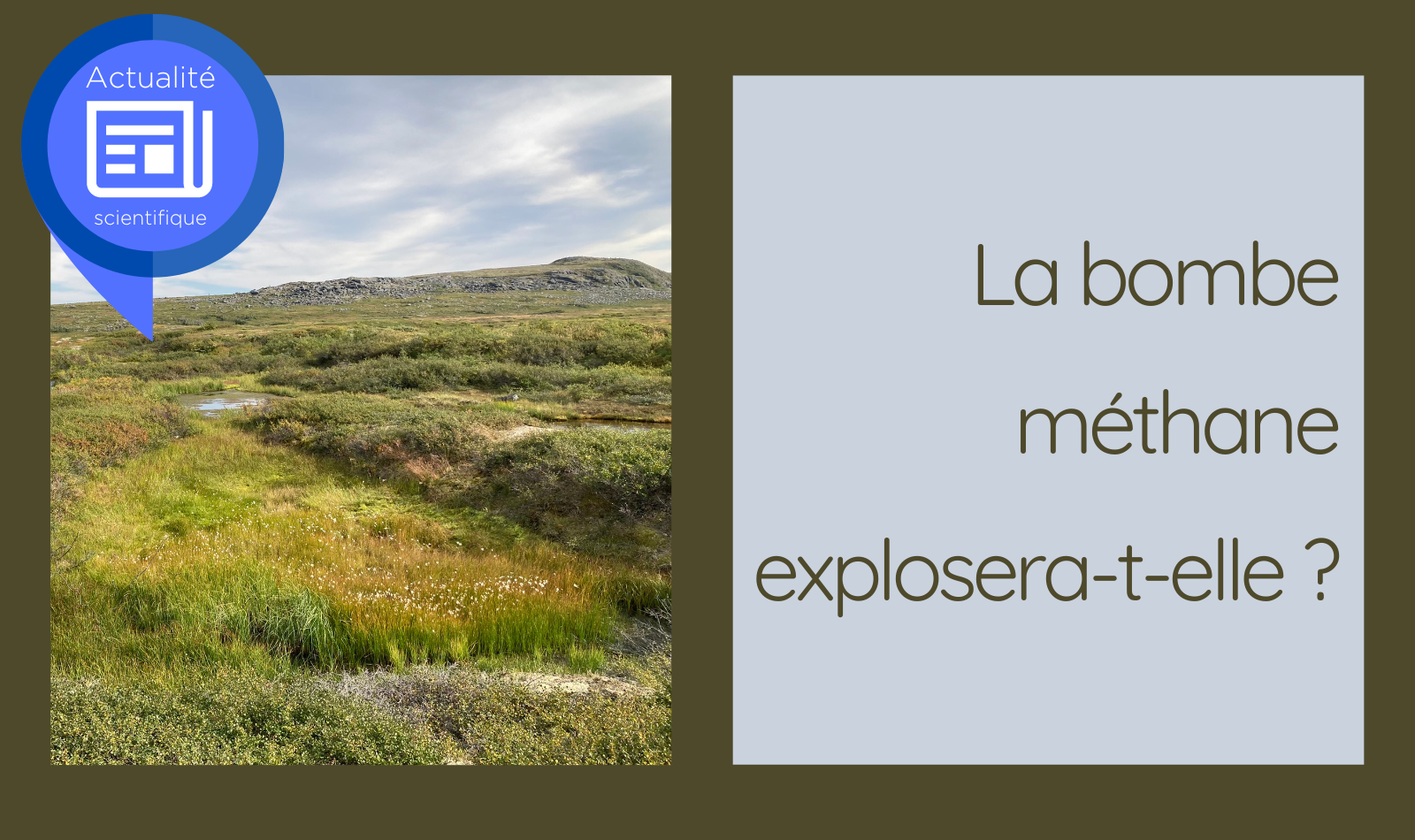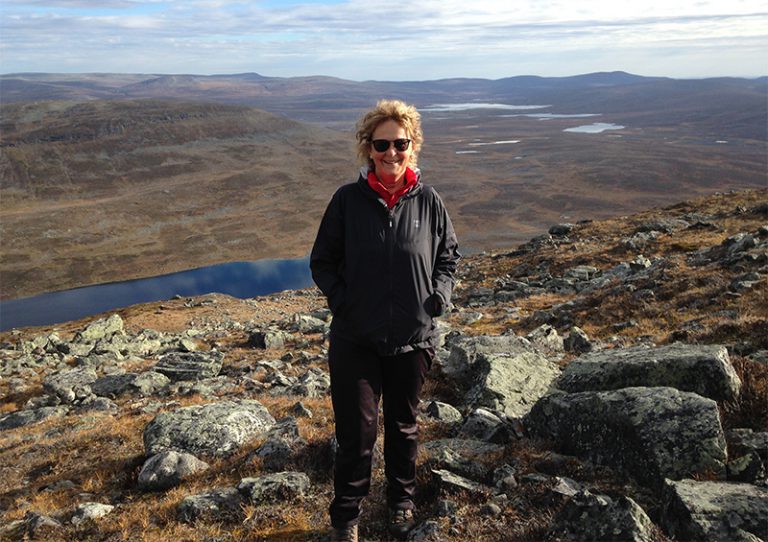Published on October 24 2022 In Scientific news
Will the methane bomb explode?

An article by Valérie Levée, science journalist
With climate change and thawing permafrost, peatlands are often considered a "methane bomb" (Miner et al, 2022). This overlooks the fact that climate change is also resulting in greening of the Arctic and increased CO2 uptake through photosynthesis. The outcome may not lead to the anticipated methane bomb. Michelle Garneau, a professor in the Department of Geography at the Université du Québec à Montréal, explains.
If forests are vast carbon sinks, we must not forget peatlands. On the planet, peatlands account for an accumulation of about 560 gigatonnes of carbon (Hugelius et al, 2020) compared to 595 gigatonnes for forests (Pan et al, 2011) and this accumulation is mainly due to northern peatlands. Over the years, Michelle Garneau and her team have scoured Canada's peatlands to document the dynamics of carbon accumulation, and a current study suggests that high-latitude peatlands have accumulated between 5 and 8 gigatonnes of carbon over the past 100 years.
Between photosynthesis and decomposition
In peatlands, it is mainly the sphagnum mosses that accumulate carbon and this accumulation is the result of two antagonistic phenomena: the absorption of CO2 by photosynthesis and the emission of CO2 and methane by the decomposition of organic matter. However, below the surface, wet, acidic and anoxic conditions prevent the decomposition of sphagnum debris. "The accumulation of organic matter is more important than decomposition and that's why peatlands are net carbon sinks," says Michelle Garneau.
But climate change could alter the outcome of the equation as thawing permafrost and the formation of thermokarst pools promote the decomposition of organic matter. The gas exchange balance could tip in favor of emissions and raises fears of a methane bomb. "Many studies have focused on methane emissions from thermokarst pools, but they haven't looked at the land areas adjacent to the pools. So, we don't know the net balance of these changing peatlands," says Michelle Garneau. However, her work shows that near ponds or in former shallow ponds, the surfaces become greener and accumulate more carbon.
A revival of photosynthetic activity
Aerial images show that the bogs are turning green. The frozen, dry and mostly lichen-covered soil tends to be colonized by beds of sphagnum mosses that expand vertically and horizontally. To assess the extent of this deep accumulation, Michelle Garneau's team took core samples from the bog soil and analyzed them cm by cm. The samples were dated with 14C and 210Pb and examined under a microscope to identify plant remains. "About 20 cm below the surface, conifer needles and seeds were identified in a highly decomposed woody peat above which sphagnum moss has accumulated since about 1990. This means that there has been a hydrological change to allow the bryophytes to grow," describes Michelle Garneau. Scientists have an indicator to estimate the level of water in a bog: Thecamoebians. These are amoebae that are sensitive to water conditions and have a siliceous shell that resists decomposition and allows them to be identified. "The different genera occupy particular ecological niches depending on the height of the water level. In each slice of core, we can reconstruct the level of the water table during a given period," explains Michelle Garneau. The Thecamoebians observed in the core studied by her team (Lamarre et al, 2012) do indicate a variation in water content that also corresponds to the change in vegetation. This transition from conifers to sphagnum mosses resulted in an increase in the rate of organic matter accumulation. Sphagnum accumulation over a 30-year period represents a thickness of 12 cm in the core, whereas the accumulation of coniferous woody debris over a 120-year period between 1990 and 1870 represents only 7 cm. The recent accumulation will compact and partially decompose," acknowledges Michelle Garneau, "but the growth continues to increase year after year compared to that of the past. This is evidenced by the carbon content measurements: 170 g/m2/yr in the sphagnum sections and 23.6 g/m2/yr in the woody debris sections.
Thus, there is a vertical accumulation of sphagnum moss that is reflected in an increase in carbon accumulation in the bogs.

Which way will it go?
It is true that thawing permafrost increases the decomposition of organic matter in thermokarst ponds and leads to methane emissions. But climate change also extends the growing season, allowing colonization by sphagnum moss, which results in increased carbon accumulation in peatlands. The research results do not yet confirm which way the balance between decomposition and accumulation will go and whether the methane bomb will explode or not. This is an equation that Michelle Garneau will try to solve in her new collaboration with Pascale Roy-Léveillé, holder of the new Sentinel North Chair on permafrost in Nunavik.
Chercheuse citée dans l'article

To learn more:
Hugelius, G., Loisel, J., Chadburn, S. and Yu, Z. (2020). Large stocks of peatland carbon and nitrogen are vulnerable to permafrost thaw. Proceedings of the National Academy of Sciences, 117, 20438-20446
https://www.pnas.org/doi/10.1073/pnas.1916387117
Lamarre, A., Garneau, M., and Asnong, H. (2012). Holocene paleohydrological reconstruction and carbon accumulation of a permafrost peatland using testate amoeba and macrofossil analyses, Kuujjuarapik, subarctic Québec, Canada. Review of Palaeobotany and Palynology, 186, 131-141.
https://www.sciencedirect.com/science/article/abs/pii/S0034666712001091
Miner, K.R., Turetsky, M.R., Malina, E., Bartsch, A., Tamminen, J., McGuire, A.D., Fix, A., Sweeney, C., Elder, C.D. and Miller, C.E. (2022). Permafrost carbon emissions in a changing Arctic. Nature Reviews Earth & Environment, 3, 55-67
https://doi.org/10.1038/s43017-021-00230-3
Pan, Y., Birdsey, R.A., Fang, J., Houghton, R, Kauppi, P.E., Kurz, W.E., Phillips, O.L, Shvidenko, A., Lewis, S.L., [+ 9 authors], and Hayes D. (2011). A large and persistent carbon sink in the world’s forests. Science 333, 988-993 https://www.science.org/doi/10.1126/science.1201609
 Science News
Science News
Spotlight on Northern Research | An initiative of Institut nordique du Québec
To celebrate Quebec's excellence in northern research and to highlight the various challenges and issues related to these territories, Institut nordique du Québec offers you a series of articles dedicated to the research conducted in its community.
Over the months, you will discover a multidisciplinary research community whose strength lies in the complementary expertise of its members. You will meet individuals who share a strong attachment to the North and who are dedicated to producing, in collaboration with the inhabitants of the region, the knowledge necessary for its sustainable and harmonious development.
You are invited to relay this and subsequent articles to your network, thus enabling the greatest number of people to discover the different facets of northern research and the many faces that animate it. Together for the North
Back to news

